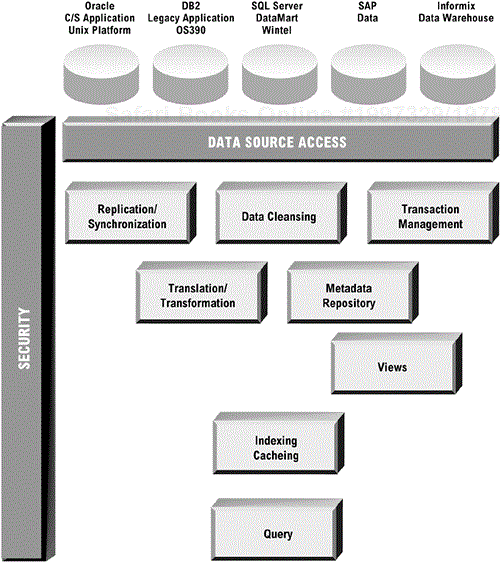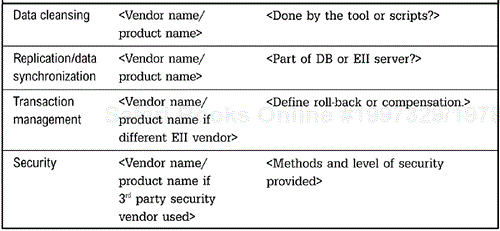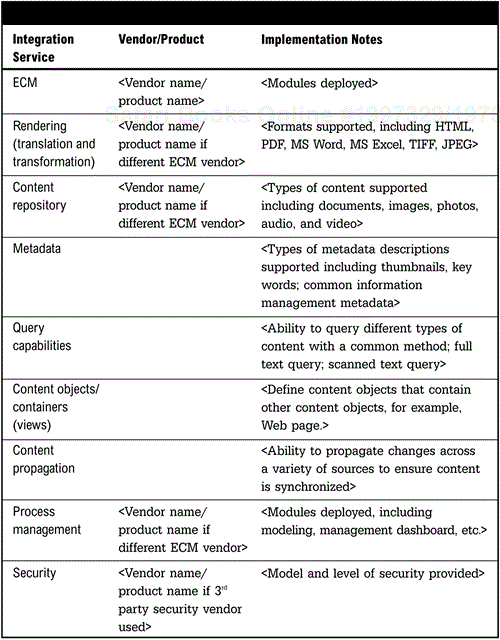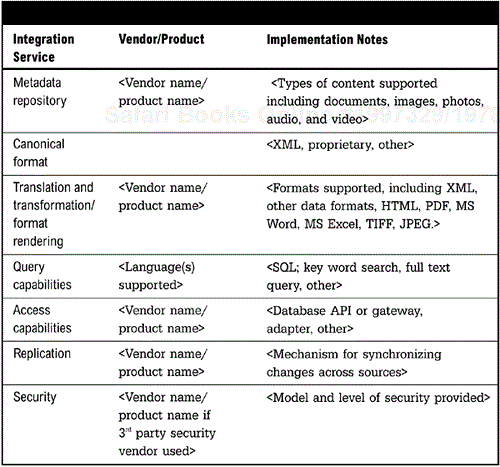<ENTERPRISE NAME>
<PLACE LOGO HERE>
<author><version><revision date>
This is a template for the Information Integration Implementation Specification. This page should be removed prior to publication of the specification. The template is a guide for the enterprise and should not be blindly followed. The organization should
Review the chapter in the book that refers to the template to understand its use.
Examine the template outline and determine what additions might be necessary based on unique organizational needs.
If absolutely necessary, remove any sections that will not apply. (The authors strongly discourage this practice.)
Save the template for future use.
Begin to develop the document.
Guidance is given for preparation of the document throughout the template.
Text shown as normal text should be utilized in the document. It may be modified as necessary.
Text shown in pointed brackets is either instructional guidance in the application of the document or a description of the type of information to be added and should be removed prior to publication.
Text shown in double pointed brackets is a placeholder for the insertion of text by the authors.
Headers and footers should be customized as necessary as a final step in the completion of the document.
Information Integration Implementation Specification
<This specification provides implementation guidance for the development of an information integration solution. It is most likely that the information integration oriented design specification from Chapter 8 will form the basis for the implementation.
Information integration represents a specific style of integration. This style is to solve problems where information from various sources needs to accessed and updated. Types of problems that are well suited to information integration are
Creating a single view of a customer or other resource
Enterprise data inventory and management
Real time reporting and analysis
Updating a data warehouse
Creating a virtual data warehouse
Providing an infrastructure for enterprise information management including all forms of digital media
Updating common information across information sources
Creating portal applications containing both structured and unstructured data from disparate systems
This section describes the specific technical problems that are being addressed in the implementation to give context to the specific implementation.>
<The scope of an information integration specification is limited to the specifics of the information and systems that are being integrated. It should cover organizations, information, systems, and the expected end result.>
<This section identifies all stakeholders in the implementation, including business managers who control all or part of the systems, data stewards or those responsible for data quality, system designers and architect(s), and the development team who will execute the implementation. Any other participants or stakeholders should also be identified, including their roles.>
<There are several basic implementation patterns for an information integration solution. This section defines the particular pattern that is being used and provides details on the configuration of the specific components of the implementation.
These patterns are

Data Integration Reference Architecture
<Data integration involves structured data, generally found in different databases across the organization. Data integration and aggregation services include accessing disparate data sources as if they were a single database (including the ability to make a single SQL call across databases), translation and transformation, support for different views (virtual tables) of consolidated information, data cleansing, and transaction management when required for publishing changes to data. (See diagram on page 361.)
The Data Integration Implementation Table specifies all the integration services provided along with relevant implementation details. Modify the following template to define the specific implementation.>


Data Integration Implementation Table
<Unstructured data that needs to be integrated with Web portals and applications include documents, images, photos, audio, video, and other digital media. All of this unstructured content requires a common set of services. The services provided by ECM solutions include content repository, search (query) capability, version control (check in/out), replication of content changes, integration, content rendering (translation/transformation), security, process modeling and management, and content delivery.

Unstructured Content Integration Reference Architecture
The Unstructured Information Implementation Table specifies all the integration services provided, along with relevant implementation details. Modify the following template to define the specific implementation.>

Unstructured Content Integration Implementation Table
<A metadata repository is essentially a database that contains information about data sources. The enterprise metadata repository contains all of the metadata on information and application sources along with information on how to access this information. An active metadata repository contains the access mechanisms as well. The metadata repository also contains new metadata descriptions, such as canonical format, that can be mapped onto the source metadata either directly or by applying transformation or calculation rules.
Because EII and ECM solutions could each have their own metadata repositories, a company could wind up with multiple repositories to manage, and metadata that needs to be synchronized and integrated. In principle, the metadata repository should provide a level of abstraction that makes it easier to consolidate, integrate, and manage distributed information. In practice, the company may need to create a multi-tiered metadata architecture to provide the levels of abstraction necessary to deliver this agility.

Metadata Repository Integration Reference Architecture
The Metadata Repository Integration Implementation Table details the capabilities of the metadata repository, including which services are supported. Because EII and ECM solutions could each have their own metadata repositories, a company could wind up with multiple repositories to manage and metadata that needs to be synchronized and integrated. In principle, the metadata repository should provide a level of abstraction that makes it easier to consolidate, integrate, and manage distributed information. In practice, the company may need to create a multi-tiered metadata architecture to provide the levels of abstraction necessary to deliver this agility. The architecture diagram and specification table should include all metadata sources. Modify the following template to define the specific implementation.>

Metadata Repository Integration Implementation Table
<The appendix should list any reference documents used in the creation of the document so that its contents can be traced back to their sources if necessary. This should be broken down into internal documents and external documents. Internal documents are those that belong to the organization. External documents are items such as articles, whitepapers, Web sites, or product documentation.>
